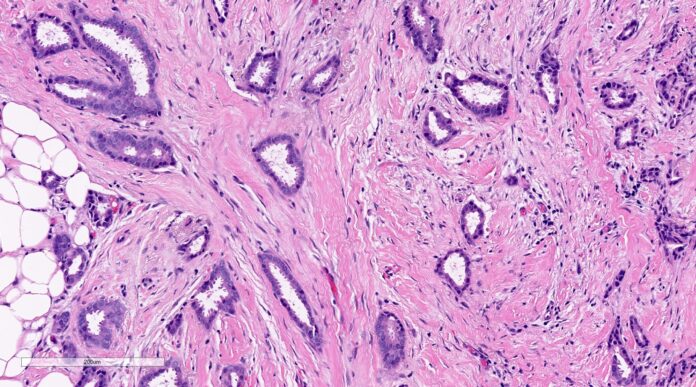Tubular carcinoma is a type of invasive breast cancer characterized by tube-shaped structures in the tumor. It is a relatively rare form of breast cancer, accounting for about 1-2% of all breast cancer cases. This type of cancer is generally considered to have a favorable prognosis compared to other forms of invasive breast cancer.
Symptoms
- Lump in the Breast: The most common symptom is the presence of a lump in the breast, which may be felt during a self-exam or a clinical breast exam.
- Changes in Breast Shape or Size: Any noticeable change in the shape or size of the breast can be a symptom.
- Nipple Discharge: Unusual discharge from the nipple can also be a sign.
- Skin Changes: Redness, dimpling, or other changes in the skin of the breast may occur.
- Nipple Changes: Inversion or changes in the appearance of the nipple.
Causes
The exact cause of tubular carcinoma, like other forms of breast cancer, is not well understood, but several factors may contribute to its development:
- Genetic Mutations: Inherited genetic mutations, such as BRCA1 and BRCA2, can increase the risk.
- Hormonal Factors: Hormonal imbalances or prolonged exposure to estrogen may play a role.
- Family History: A family history of breast cancer can increase the risk.
- Age: The risk increases with age, most commonly affecting women over 50.
- Lifestyle Factors: Obesity, alcohol consumption, and lack of physical activity can contribute to the risk.
Treatment
Treatment for tubular carcinoma typically involves a combination of surgery, radiation therapy, and possibly hormone therapy. Chemotherapy is less commonly used due to the generally favorable prognosis.
- Surgery:
- Lumpectomy: Removal of the tumor and a small margin of surrounding tissue.
- Mastectomy: Removal of the entire breast, especially if the cancer is more widespread.
- Radiation Therapy:
- Often used after a lumpectomy to destroy any remaining cancer cells.
- Hormone Therapy:
- For hormone receptor-positive cancers, drugs like tamoxifen or aromatase inhibitors may be used to block the effects of estrogen.
- Chemotherapy:
- Less common for tubular carcinoma but may be used in more aggressive cases.
Prevention
While there is no sure way to prevent tubular carcinoma, certain measures can help reduce the risk:
- Regular Screenings: Routine mammograms and clinical breast exams can help detect cancer early.
- Healthy Lifestyle: Maintaining a healthy weight, exercising regularly, and limiting alcohol intake can lower the risk.
- Hormone Replacement Therapy: Discussing the risks and benefits with a doctor before starting hormone replacement therapy during menopause.
- Genetic Counseling and Testing: For those with a family history of breast cancer, genetic counseling and testing for mutations like BRCA1 and BRCA2 can be beneficial.
Early detection and prompt treatment are key to managing tubular carcinoma effectively. Regular follow-ups and monitoring are essential for those diagnosed with this type of cancer.

































